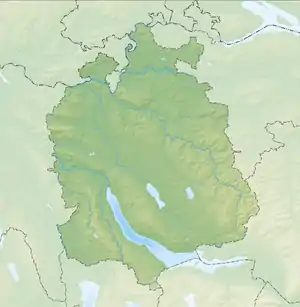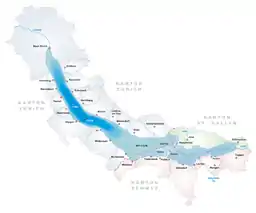Thalwil | |
|---|---|
 | |
 Coat of arms | |
Location of Thalwil | |
 Thalwil  Thalwil | |
| Coordinates: 47°17′N 8°34′E / 47.283°N 8.567°E | |
| Country | Switzerland |
| Canton | Zurich |
| District | Horgen |
| Government | |
| • Mayor | Gemeindepräsident Christine Burgener CVP/PDC (as of 2008) |
| Area | |
| • Total | 5.53 km2 (2.14 sq mi) |
| Elevation | 486 m (1,594 ft) |
| Population (31 December 2018)[2] | |
| • Total | 17,990 |
| • Density | 3,300/km2 (8,400/sq mi) |
| Time zone | UTC+01:00 (Central European Time) |
| • Summer (DST) | UTC+02:00 (Central European Summer Time) |
| Postal code(s) | 8800 |
| SFOS number | 0141 |
| Surrounded by | Erlenbach, Herrliberg, Horgen, Küsnacht, Langnau am Albis, Oberrieden, Rüschlikon |
| Twin towns | La Tour-de-Peilz (Switzerland) |
| Website | www SFSO statistics |
Thalwil is a municipality and town in the district of Horgen in the canton of Zürich in Switzerland. In addition to the town of Thalwil, the municipality includes the village of Gattikon.
History
Thalwil is first mentioned around 1030 as Talwile villam, which is derived from Tellewilare, Tello's Farm, and indicates the early medieval origins of Thalwil as an Alemannic farmstead. Only a few graves remain from this period. In 1133, it was mentioned as Telwil.[3]
The parish of Thalwil originally comprised four Wachten (hamlets):
- Ludretikon, the oldest hamlet (mentioned in 915), bordering Rüschlikon
- Oberdorf (Upper Village), the area around the church
- Unterdorf (Lower Village), the area roughly south of the railway station
- Langnau, which separated from Thalwil around 1713
In medieval times, the economy consisted mainly of farms, vineyards as well as a small amount of fishing, crafts and shipping (on the lake). This estate was once owned by the Dukes of Habsburg and held by the Barons of Eschenbach. The Abbeys of Muri and Wettingen also had significant interests and owned 12 and 3 farms respectively.
Thalwil also boasts the oldest wood corporation in the Canton of Zurich, the Bannegg-Waldung. It was first mentioned in 1483, when Muri Abbey granted it to the twelve beneficiaries of the Abbey farms in Thalwil. Today the corporation is owned by 16 members as well as by the Thalwil Gemeinde.
Geography



The municipality of Thalwil is located on the Zimmerberg ridge between the western shore of Lake Zurich and the Sihl river. It includes the town of Thalwil, on the eastern slopes of the ridge alongside the lake, and the village of Gattikon, on the westen slopes and the bank of the Sihl. Thalwil borders on the communes of Rüschlikon, Langnau am Albis, Oberrieden, Horgen and (across the lake) Erlenbach.
The municipality has an area of 5.5 km2 (2.1 sq mi). Of this area, 18% is used for agricultural purposes, while 23.8% is forested. Of the rest of the land, 56.1% is settled (buildings or roads) and the remainder (2.2%) is non-productive (rivers, glaciers or mountains).[4] In 1996 housing and buildings made up 42.3% of the total area, while transportation infrastructure made up the rest (13.7%).[5] Of the total unproductive area, water (streams and lakes) made up 1.4% of the area. As of 2007 51.3% of the total municipal area was undergoing some type of construction.[5]
Coat of arms
The Gemeindewappen (communal flag or coat of arms) consists of two diagonally crossed black bulrushes with green stems and leaves on a white background.
Demographics
Thalwil has a population of 18,066 (as of 2019).[6] As of 2007, 21.4% of the population was made up of foreign nationals. As of 2008, the gender distribution of the population was 48.5% male and 51.5% female. Over the last 10 years the population has grown at a rate of 6%. Most of the population (as of 2000) speaks German (84.0%), with Italian being second most common (4.5%) and English being third (2.3%).
The age distribution of the population (as of 2000) is children and teenagers (0–19 years old) make up 18.8% of the population, while adults (20–64 years old) make up 65.6% and seniors (over 64 years old) make up 15.6%. In Thalwil about 81.5% of the population (between age 25–64) have completed either non-mandatory upper secondary education or additional higher education (either university or a Fachhochschule).[4] There are 7,680 households in Thalwil.[5]
The historical population is given in the following table:[3]
| year | population |
|---|---|
| 1634 | 601 |
| 1762 | 1,100 |
| 1799 | 1,149 |
| 1833 | 1,318 |
| 1850 | 1,889 |
| 1880 | 3,293 |
| 1900 | 6,791 |
| 1950 | 8,787 |
| 1990 | 15,647 |
| 2000 | 15,749 |
| 2010 | 17,189 |
| 2020 | 18,263 |
Election results
In the 2007 elections, the most popular party was the SVP, receiving 28.5% of the vote. The next three most popular parties were the SP (19.7%), the FDP (18.2%), and the CSP (11.4%).
The most recent Swiss federal elections for the Nationalrat (National Council) and Ständerat (Council of States) took place in 2019. In the Nationalrat elections, the largest party in Thalwil was the SVP, with 21.6% of the vote. Five other parties received over a hundred votes. Those were, in order of descending votes: the FDP (20.1%), the GLP (14.8%), the SP (14.5%), the Greens (9.9%), and the CVP (now known as The Centre) (5.0%).[7] In the canton-wide Ständerat election, Ruedi Noser of the FDP was reelected after the second round, winning 65.3% of votes in Thalwil.[8]
Churches in Thalwil


Thalwil is one of the oldest parishes on the shores of Lake Zurich. It also has one of the most spectacular church locations, with the Platte affording views of the lake and its surroundings from Zurich to the Alps.
The earliest recorded church was dedicated to St Martin in 1159. In medieval times it was a dependency of Wettingen Abbey. Although it was frequently hit by lightning and also looted and set on fire during the Old Zürich War (Alter Zürichkrieg), the original building survived for over six hundred years.
In 1845, the small and rather dilapidated chapel was demolished and replaced by a much larger church designed by Ferdinand Stadler. A fire set off during repairs on the tower burnt down the new church almost 100 years later (1943) but the building was soon completely restored and has survived to this day.
As of 2008, there were 5382 Catholics and 5881 Protestants in Thalwil. In the 2000 census, religion was broken down into several smaller categories. From the census, 41.5% were some type of Protestant, with 39.3% belonging to the Swiss Reformed Church and 2.2% belonging to other Protestant churches. 34.3% of the population were Catholic. Of the rest of the population, 3.8% were Muslim, 5.8% belonged to another religion (not listed), 2.6% did not give a religion, and 15% were atheist or agnostic.[5]
Industrialisation
In the late 1830s, the lakeside road (Seestrasse) was opened. It soon attracted large silk, cotton and other textile factories to the former farming village, some run by local families such as Schwarzenbach, Schmid, and Kölliker. This growth was boosted by the new railway lines from Zurich to Pfäffikon (1875) and Zug (1897). Industrialisation brought new workers into the former farming village and increased the population from 1,318 (in 1833) to 6,791 (in 1900).
As of 2020, Thalwil has an unemployment rate of 3.1%.[9] As of 2018, there were 5 people employed in the primary economic sector and 2 businesses involved in this sector. 1,001 people are employed in the secondary sector and there are 106 businesses in this sector. 5,576 people are employed in the tertiary sector, with 1,193 businesses in this sector.[9] As of 2007, 28.6% of the working population were employed full-time, and 71.4% were employed part-time.[5]
Taxes
According to the statistical office of Canton Zurich, Thalwil receives 92.0 million Franc in tax revenue every year, as of 2020. 11,022 people pay taxes to Thalwil.[9]
Modern-day Thalwil
Today this industrial past has all but vanished. The economy of Thalwil is mainly supported by a variety of small and medium-sized businesses, many located in the Böhni commercial estate opened in 1971. This includes Unisys Switzerland, which is the largest employer in Thalwil (over 500 jobs). There is also a range of shops, mainly located around the Gotthardstrasse.
The main source of Thalwil's current prosperity lies in the large number of commuters (ca. 7 000) who live there but work in the economic centres of Greater Zurich. Today, Thalwil has mostly left its farming and industrial past behind and become a commuter base.
Transportation
Thalwil is located along the A3 motorway from Zurich to Chur as well as on the main railway lines from Zurich to Chur, Lucerne and Italy. In the summer, there are regular boats to Zurich as well as along the lake to Rapperswil, run by the Zürichsee-Schifffahrtsgesellschaft. Thalwil railway station is served by lines S2, S8, and S24 of the Zürich S-Bahn. The Zimmerberg bus line (Zimmerbergbus), provided by the Sihltal Zürich Uetliberg Bahn (SZU), connects the Zimmerberg region and parts of the Sihl valley.
Sightseeing
- Church with views over the lake
- Pfisterhaus with the village museum
- Etzliberg viewing point and old half-timbered houses
- Villa Diana, the 19th-century neo-baroque residence of factory owner Julius Schwarzenbach
Notable people


- Tina Keller-Jenny (1887-1985) Swiss physician and Jungian psychotherapist, brought up in the Jenny-Castle, Thalwil
- Hans Johner (1889 – 1975 in Thalwil) a Swiss chess player and musician
- Ferdinand Sigg (1902 in Thalwil – 1965) bishop of the Methodist Episcopal Church
- George Piranian (1914 in Thalwil – 2009) a Swiss-American mathematician of Swiss and Armenian descent, emigrated to the US in 1929
- Ursula Schäppi (born 1940), actress, playwright and comedian; lives in Thalwil [10]
- Urs Schwarzenbach (born 1948 in Thalwil), UK-based Swiss billionaire financier
- Bruno Saile (born 1952 in Thalwil) a Swiss rower
- Reto Salimbeni (born 1958, in Thalwil) a filmmaker and director known for his features and commercials [11]
- Martin Bäumle (born 1964 in Thalwil) is a Swiss scientist and politician
- Manuela Müller (born 1980 in Thalwil) a Swiss freestyle skier, competed at the 2002 and 2006 Winter Olympics
- Adrian Winter (born 1986 in Thalwil) a Swiss professional footballer, over 250 club caps
See also
- Spelunke in vivo
References
- ↑ "Arealstatistik Standard - Gemeinden nach 4 Hauptbereichen". Federal Statistical Office. Retrieved 13 January 2019.
- ↑ "Ständige Wohnbevölkerung nach Staatsangehörigkeitskategorie Geschlecht und Gemeinde; Provisorische Jahresergebnisse; 2018". Federal Statistical Office. 9 April 2019. Retrieved 11 April 2019.
- 1 2 Thalwil in German, French and Italian in the online Historical Dictionary of Switzerland.
- 1 2 Swiss Federal Statistical Office accessed 10-Aug-2009
- 1 2 3 4 5 Statistics Zurich (in German) accessed 4 August 2009
- ↑ "mycity.ch - Thalwil - Gemeindeverwaltung". mycity.ch. Retrieved 2019-05-30.
- ↑ "CH: Nationalratswahl 2019 Thalwil Wahlzettelrapport" (PDF). Gemeinde Thalwil. 20 Oct 2019. Retrieved 1 Oct 2021.
- ↑ "Erneuerungswahl eines zürcherischen Mitgliedes des Ständerates für die Amtsdauer 2019–2023, 2. Wahlgang" (PDF). Gemeinde Thalwil. 17 Nov 2019. Retrieved 1 Oct 2021.
- 1 2 3 "Gemeindeporträt Thalwil". Kanton Zürich Gemeindeporträts. 2020. Retrieved 22 October 2021.
- ↑ IMDb Database retrieved 12 January 2019
- ↑ IMDb Database retrieved 12 January 2019
External links
- Official website of the Thalwil Gemeinde (in German)
- Thalwil in German, French and Italian in the online Historical Dictionary of Switzerland.
- Blog about life in Thalwil (in English)
- Thalwiler Anzeiger newspaper (in German)

